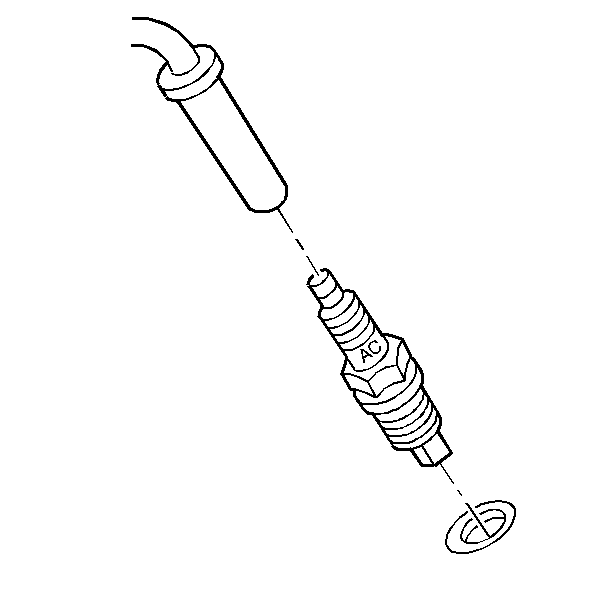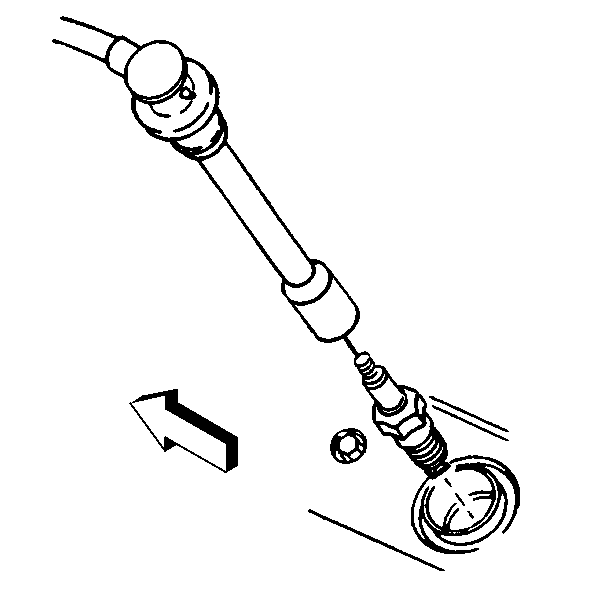Spark Plug 3100 Engine L82
Removal Procedure
Notice: Observe the following service precautions:
• Allow the engine to cool before removing the spark plugs. Attempting
to remove spark plugs from a hot engine may cause the plug to seize, causing
damage to the cylinder head threads. • Clean the spark plug recess area before removing plug. Failure
to do so can result in engine damage due to dirt or foreign material entering
the cylinder head, or in contamination of the cylinder head threads. Contaminated
threads may prevent proper seating of the new plug. • Use only spark plugs specified for use in the vehicle. do not
install spark plugs that are either "hotter" or "colder"
than those specified for the vehicle. Refer to SECTION 0B for spark plug usage
information. Installing plugs of another type can severely damage the engine.
- Turn OFF the ignition.
- Remove the spark plug wire(s) from the spark plug(s). Refer to Spark Plug Wires Not Operating Properly .
- Remove the spark plug(s) from the engine.

Installation Procedure
Notice: It is important to check the gap of all new and reconditioned spark plugs before installation. Pre-set gaps may have changed during handling. Use a round wire feeler gauge to be sure of an accurate check, particularly on used plugs. Installing plugs with the wrong gap can cause poor engine performance and may even damage the engine.
Notice: Be sure plug threads smoothly into cylinder head and is fully seated. Use a thread chaser if necessary to clean threads in cylinder head. Cross-threading or failing to fully seat spark plug can cause overheating of plug, exhaust blow-by, or thread damage. Follow the recommended torque specifications carefully. Over or under-tightening can also cause severe damage to engine or spark plug.
- Install the spark plug(s) to the engine.
- Install the spark plug wire(s) from the spark plugs. Refer to Spark Plug Wires Not Operating Properly .

Tighten
Tighten the spark plug(s) to 20 N·m (11 lb
ft).
Spark Plug 3.4L Engine LQ1
Removal Procedure
Notice: Observe the following service precautions:
• Allow the engine to cool before removing the spark plugs. Attempting
to remove spark plugs from a hot engine may cause the plug to seize, causing
damage to the cylinder head threads. • Clean the spark plug recess area before removing plug. Failure
to do so can result in engine damage due to dirt or foreign material entering
the cylinder head, or in contamination of the cylinder head threads. Contaminated
threads may prevent proper seating of the new plug. • Use only spark plugs specified for use in the vehicle. do not
install spark plugs that are either "hotter" or "colder"
than those specified for the vehicle. Refer to SECTION 0B for spark plug usage
information. Installing plugs of another type can severely damage the engine.
- Turn OFF the ignition.
- Remove the upper intake manifold. Refer to Upper Intake Manifold Replacement in Engine Mechanical.
- Remove the spark plug wire(s) from the spark plug(s). Refer to Spark Plug Wires Not Operating Properly .
- Remove the spark plug(s) from the engine.

Installation Procedure
Notice: It is important to check the gap of all new and reconditioned spark plugs before installation. Pre-set gaps may have changed during handling. Use a round wire feeler gauge to be sure of an accurate check, particularly on used plugs. Installing plugs with the wrong gap can cause poor engine performance and may even damage the engine.
Notice: Be sure plug threads smoothly into cylinder head and is fully seated. Use a thread chaser if necessary to clean threads in cylinder head. Cross-threading or failing to fully seat spark plug can cause overheating of plug, exhaust blow-by, or thread damage. Follow the recommended torque specifications carefully. Over or under-tightening can also cause severe damage to engine or spark plug.
- Install the spark plug(s) to the engine.
- Install the spark plug wire(s) from the spark plugs. Refer to Spark Plug Wires Not Operating Properly .
- Install the upper intake manifold. Refer to Upper Intake Manifold Replacement in Engine Mechanical.

Tighten
Tighten the spark plug(s) to 20 N·m (11 lb
ft).
Spark Plug 3800 Engine L36 and L67
Removal Procedure
Notice: Observe the following service precautions:
• Allow the engine to cool before removing the spark plugs. Attempting
to remove spark plugs from a hot engine may cause the plug to seize, causing
damage to the cylinder head threads. • Clean the spark plug recess area before removing plug. Failure
to do so can result in engine damage due to dirt or foreign material entering
the cylinder head, or in contamination of the cylinder head threads. Contaminated
threads may prevent proper seating of the new plug. • Use only spark plugs specified for use in the vehicle. do not
install spark plugs that are either "hotter" or "colder"
than those specified for the vehicle. Refer to SECTION 0B for spark plug usage
information. Installing plugs of another type can severely damage the engine.
- Turn OFF the ignition.
- Remove the spark plug wire(s) from the spark plug(s). Refer to Spark Plug Wires Not Operating Properly .
- Remove the spark plug(s) from the engine.

Installation Procedure
Notice: It is important to check the gap of all new and reconditioned spark plugs before installation. Pre-set gaps may have changed during handling. Use a round wire feeler gauge to be sure of an accurate check, particularly on used plugs. Installing plugs with the wrong gap can cause poor engine performance and may even damage the engine.
Notice: Be sure plug threads smoothly into cylinder head and is fully seated. Use a thread chaser if necessary to clean threads in cylinder head. Cross-threading or failing to fully seat spark plug can cause overheating of plug, exhaust blow-by, or thread damage. Follow the recommended torque specifications carefully. Over or under-tightening can also cause severe damage to engine or spark plug.
- Install the spark plug(s) to the engine.
- Install the spark plug wire(s) from the spark plugs. Refer to Spark Plug Wires Not Operating Properly .

Tighten
Tighten the spark plug(s) to 20 N·m (11 lb
ft).
